July 10, 2009
Air Date: July 10, 2009
FULL SHOW
SEGMENTS
As Unclear as Water
View the page for this story
Labels on bottled water make it difficult for consumers to discern what is in their water: has it been purified or tested? A Congressional hearing and two new reports illustrate the lack of information that consumers have about what’s in a bottle of water. Host Jeff Young talks with Jane Houlihan, the Senior Vice President for research at the Environmental Working Group about the consumer’s right to know what’s in bottled water. We also hear from Tom Lauria of the International Bottled Water Association who says that the labels provide adequate information. (06:35)
Low-Carbon Internet Surfing
View the page for this story
All of the news, video and mail you access online has to live somewhere. These houses of information need large amounts of energy to run. Chris Page, Director of Climate and Energy Strategy at Yahoo!, gives host Jeff Young a tour of one such data center in Silicone Valley. She also talks about Yahoo’s plan for cutting their CO2 emissions in half. (05:50)
The Greenest House
/ Lonny ShavelsonView the page for this story
David Gottfried believes that green is beautiful and he has renovated his house to prove it. His 1915 Craftsman home in Berkeley, California is so energy efficient that it has received the highest U.S. building rating for a reconstructed building - a platinum LEED certification. Reporter Lonny Shavelson went to visit this environmental Eden to see if there are eco-lessons for the average homeowner. (07:00)
Better, Greener Real Estate
View the page for this story
The principles of smart growth and green building have come together in the first national standard for green neighborhood design. Sophie Lambert of the U.S. Green Building Council tells host Steve Curwood that the LEED for neighborhood development rating system has the potential to change how developers and local governments can work together to create healthy and environmentally-sound neighborhoods. (07:00)
Mired in the Mud on the Road to Copenhagen
View the page for this story
The Obama administration's debut at the World Economic Summit ends with little progress made toward a global climate change treaty expected by December in Copenhagen. The G8 agreed for the first time that a global temperature increase beyond 2 degrees Celsius would be dangerous, but didn't set goals that would encourage developing countries, like China and India, to reduce their greenhouse gas emissions. Host Steve Curwood talks with climate diplomacy expert Jennifer Morgan about how the world can work together to get back on the road to Copenhagen. (03:45)
Protecting the Planet from Nuclear Terrorism
View the page for this story
President Barack Obama wants to host a global summit on nuclear security next year. He's called nuclear terrorism the gravest threat the world faces, and political scientist Graham Allison agrees. Graham Allison, author of the book "Nuclear Terrorism" tells host Steve Curwood that we're more likely than not to experience a nuclear or biological weapons attack in the next five years-- a preventable tragedy that would change the world forever (17:20)
Show Credits and Funders
Show Transcript
Hosts: Steve Curwood and Jeff Young
Guests: Graham Allison, Jane Houlihan, Jennifer Morgan, Sophie Lambert, Chris Page
Reporters: Lonny Shavelson
[THEME]
CURWOOD: From Public Radio International - this is Living on Earth.
[THEME]
CURWOOD: I’m Steve Curwood.
YOUNG: And I’m Jeff Young.
The labels say pure and natural – but good luck getting any real information about how bottled water is purified.
HOULIHAN: It really is very much a buyer-beware market. We’re forced to trust that bottled water companies are doing the testing they need to do, that they’re purifying the water that they’re giving us what we’re paying for.
YOUNG: We go to the source for some answers. Also – green houses – in green neighborhoods.
CURWOOD: Plus – why President Obama calls nuclear terrorism the threat above all others.
ALLISON: We can now vividly imagine al Qaeda getting a nuclear bomb, bringing it to an American city, destroying the heart of that city, and changing our world.
CURWOOD: A leading defense expert on how to counter and defuse that threat - and more - this week on Living on Earth! So stick around.
As Unclear as Water

YOUNG: From the Jennifer and Ted Stanley Studios in Somerville, Massachusetts, this is Living on Earth. I’m Jeff Young.
CURWOOD: And I’m Steve Curwood.
New concerns are bubbling up about bottled water. We all know about the waste from all those plastic bottles. But two new reports and a recent congressional hearing focused on the labels on those bottles, and what they do not tell us.
YOUNG: The Government Accountability Office found that consumers get less information about the source and quality of bottled water than they do about plain old tap water. The non-profit Environmental Working Group graded bottled waters on the information provided and, let’s just say most major name brands won’t be making the dean’s List.
Jane Houlihan’s with us to tell us about that report. She’s Environmental Working Group’s vice president for research. Ms. Houlihan, welcome to the program.
HOULIHAN: Thank you.
YOUNG: Got me a bottle of Pellegrino water here because my throat’s a little dry. I’m just going to have a sip.
[DRINKING SOUNDS]
YOUNG: Mmm. You know, it says right here on the label it’s natural and it was bottled at the source. And I paid a pretty penny for this water. So I’m assuming, of course, that means this is pretty good for me, right?
HOULIHAN: It may be or it may not be. So often you can’t tell exactly where the water comes from or how it’s treated or even if it’s treated, and you can’t tell what contaminants it might contain. What we find is that Pellegrino in our scorecard receives a grade of F.
YOUNG: F?
HOULIHAN: F.
YOUNG: A failing grade, but it says right here on the label it’s natural. Let’s talk about marketing for a moment. We hear phrases like “essential,” “pure,” “crystal fresh”. What does that mean?
HOULIHAN: Right. Some waters are crisp. Other waters make claims about their healing properties. Some of them refer to legends. You know many decades ago Poland Springs claimed that its water gained its reputation for curative powers in 1793 when it cured a man on his deathbed and he lived another 52 years. You know, Evian water is the symbol of health and healing and general wellbeing. Lots and lots of claims on health and purity that aren’t matched by regulations that require that the data that might back those claims up actually be made public.
YOUNG: Now is there evidence that what we don’t know about bottled water might indeed hurt us?
HOULIHAN: Well, there have certainly been some recalls over the years. But FDA doesn’t prioritize the inspection of bottled water companies. So it really is very much a buyer beware market. We’re forced to trust that bottled water companies are doing the testing they need to do, that they’re purifying the water that they’re giving us what we’re paying for. You know, you often won’t find the data you need on the label to know exactly what you’re getting.
YOUNG: Now your group did some testing in an earlier report and you found some contaminants in bottled water, right?
HOULIHAN: We did. You know some surveys have shown that about a quarter of all bottled water drinkers buy it because they think it’s free of contaminants. We tested ten major brands of bottled water and found 38 different pollutants in that water. Everything from, you know, radioactive minerals to fertilizer wastes to toxic byproducts of water disinfection. And I think that would surprise a lot of people. This water is not pure as the driven snow, like some companies advertise.
YOUNG: But the contaminants that you found are they at levels that would hurt people? I mean are you saying for example that when one of these gets an F, that it might be dangerous to drink?
HOULIHAN: This is a grade that’s about transparency, not safety. So when a company gets and F, it’s because they’re not telling people very much about where their water comes from, how it’s treated or the pollutants that are in it.
YOUNG: So what’s your recommendation here? What would you like to see let’s say Congress do about this?
HOULIHAN: Well Congress definitely needs to beef up the law when it comes to bottled water and require that bottled water companies, first of all, label their source and treatment methods right on the bottle. And there are brands that already do this. We point out a couple in our report. Ozarka drinking water labels exactly what municipal water supply their water comes from and exactly how it’s treated after they take that water from the municipal supply.
Penta is another brand that does the same. So these things easily fit on the label, and other companies could be doing the exact same thing. And we also think that bottled water companies should be required to publish their test results. They are testing. They’re required to do that under federal law. So just publish those tests, make them available to the public so that people know exactly what they’re getting.
YOUNG: What’s your recommendation to consumers in the meantime?
HOULIHAN: Consumers in the meantime can use our bottled water guide to find brands that are providing more information on water source and treatment and testing. And also, look to filtered tap water as a superior alternative. It’s much less expensive, it’s purer that tap water, and it’s a great inexpensive first choice for the water that we drink.
YOUNG: Thanks very much for your time.
HOULIHAN: You’re welcome.
YOUNG: That’s Jane Houlihan of the Environmental Working Group with the glass half empty, if you will.
Now from the glass half full point of view, Tom Lauria. He’s Vice President of communications at the International Bottled Water Association. Mr. Lauria says many companies are working to supply information.

YOUNG: Now, we took Mr. Lauria’s advice and searched out the 800 number in tiny print on the bottle’s label. An operator heard our questions about water testing and treatment and said they’d send us a report. By mail. In ten days or so.
Well, we won’t make you wait for more information. You can read those reports on bottled water and the industry’s response at our website, loe.org.
Related links:
- Check out the report and scorecard of bottled water brands.
- GAO report
- International Bottled Water Association (IBWA)
- IBWA congressional testimony press release
Low-Carbon Internet Surfing

A Yahoo Sunnyvale Data center, nicknamed Space Park, houses some of your favorite web sites. (Courtesy of Yahoo)
[SOUND OF DOOR OPENING, ROAR OF MACHINERY]
YOUNG: When you visit a web site or look up something online each click of the mouse makes a little more work for a place like this—a data center.
Former Living on Earth staffer Chris Page, who now works with Yahoo, gives us a virtual tour of Yahoo’s Sunnyvale data center in California.
PAGE: This is where the real work of the Internet happens. And what you’re basically hearing is all that cooling energy. You’ve got the fans running across the servers, which look like these humming boxes. They’re each about the size of a pizza box. And they’re in these racks. And the racks are in these aisles. And there are fans that suck the cold air from the air-handling units through the front of the servers and then spit the hot air out the back.
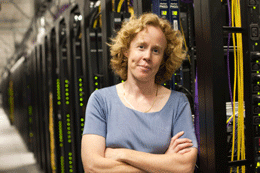
Chris Page is working to cut Yahoo's carbon footprint in half by 2014.(Courtesy of Yahoo)
[SOUND OF DOOR OPENING]
Back at her office, where we can actually hear, Page explains how Yahoo’s approach has evolved.
PAGE: Yahoo, basically – in 2007 we saw a problem we wanted to take action on immediately. And what we did was we bought offsets against out entire footprint, rendering us carbon neutral.
YOUNG: Hmm. And so, now you’re thinking no more carbon offsets, right?
PAGE: That’s right. The goal now is a 40 percent reduction in carbon intensity of our data centers by 2014. Effectively what that means is we’ll be providing the same amount of services or better in 2014 than we are today, but with 40 percent less carbon.
YOUNG: Of your carbon footprint, how much of it is just powering those big data centers, those servers?
PAGE: That’s one of the first things we discovered. The majority of it really is from data centers.
YOUNG: Hmm. And my guess is my individual contribution to that is not that great, but it adds up. How many yahoo users are there?
PAGE: We have over 500 million users worldwide.
YOUNG: Half a billion.
PAGE: Half a billion users worldwide. To give you an example: when Michael Jackson passed away recently we had 800,000 clicks on the front-page story about that within a ten minute time period.
YOUNG: Wow.
PAGE: So that’s a lot of people.
YOUNG: But you don’t always have that level of use, right?
PAGE: That’s correct.
YOUNG: But you have to plan for that level of use.
PAGE: Exactly. That’s where one of the opportunities is in terms of efficiency. Historically, when you look at capacity in a server, you have to design a cathedral for Easter or Christmas. People are going to be using that way all the time. It’s Easter and Christmas only you don’t know what day of the year Easter and Christmas is going to fall on.

A Yahoo Sunnyvale Data center, nicknamed Space Park, houses some of your favorite web sites.(Courtesy of Yahoo)
YOUNG: Do we know how big the Internet is in terms of its energy use, its CO2 output?
PAGE: In 2007, the EPA noted that over the past five years, energy consumption from data centers in the United States had doubled and was 60 billion kilowatt hours for the country. And we’re expecting within the next five years to go up to 100 billion kilowatt hours. Historically with data centers, people really haven’t paid very close attention to electricity, so you wound up having sort of the equivalent of your mom’s wood panel station wagon, very reliable, but not necessarily designed for efficient miles per gallon. What we’re looking at in the next generation of data centers that Yahoo’s trying to build is really something closer to the Tesla. Still very efficient, even more reliable, and looking for ways to reduce the waste throughout the system as much as possible.
YOUNG: But the Tesla costs $100,000.
PAGE: Yeah, well that’s where the analogy kinda breaks down a little bit because it’s not actually that much more expensive. In some cases what you’re doing is actually saving money by eliminating things like very expensive chillers and relying instead on air cooling, free air cooling, as we’re going to do in the new design we have for our upstate New York facility.
YOUNG: Now this new one that you’re building, tell us more about that. Is that going to look significantly different or behave significantly differently from your other data centers?
PAGE: It will look a little bit like a chicken coop when it’s built. And it is oriented to take advantage of the microclimate in the area. Upstate New York can be a very chilly place. We’re going to be relying 100 percent of the time on free cooling, which will drastically improve the efficiency of it.
YOUNG: What does all this tell us about how information technology overlaps with energy technology and our efforts to get cleaner energy?
PAGE: Well I think you’re gonna see some tremendous developments in the next couple of years. The impact that all this technology will have in other areas, making transportation smarter, making buildings smarter so they’re cooling themselves in a much more efficient way. All those things together, smart logistics, smart buildings and the smart grid will decrease carbon emissions by 7.8 gigatons. So the contribution of the ICT industry will be 1.3 gigatons. The reduction will be 7.8 gigatons.
YOUNG: Wow.
PAGE: I think that’s one of the really powerful things about the Internet in general and companies like Yahoo is providing technology that can make the world run more efficiently, more smoothly and with better information.
YOUNG: Chris Page is Director of Climate and Energy Strategy at Yahoo Inc., thanks very much for your time.
PAGE: You bet.
CURWOOD: Coming up: the top rated green home in America – and at the top of its winning ways is plain old-fashioned insulation.
Keep listening to Living on Earth.
[MUSIC: Cal Green “Trippin’” from “Trippin' - The Groove Merchant Compilation”.]
Related link:
Yahoo's co-founder announces plans to build an energy efficient data center near Buffalo.
The Greenest House
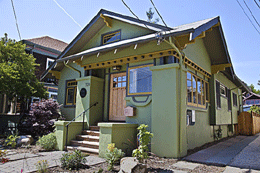
A platinum-green home. (Photo: Lonny Shavelson)
YOUNG: The U.S. Green Building Council administers a program to rate the environmental impact of buildings. It’s known as Leadership in Energy and Environmental Design, or LEED for short. The top LEED rating is platinum.
And in Berkeley, California, David Gottfried says his craftsman styled bungalow has garnered more points over platinum than any other house in the United States. Lonny Shavelson took a look.
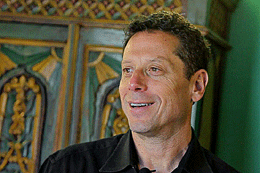
David Gottfried, eco-perfectionist. (Photo: Lonny Shavelson)
GOTTFRIED: You know, there are straw bale homes, there are earth ship homes. And I think in some ways they would beat me on ecological impact.
SHAVELSON: But competing in an eco-battle with straw bale houses isn’t Gottfried’s point. A lean middle-aged man in a baggy sweater, he looks more like an ivy-league English Lit professor than an enviro-radical. He says his goal is to show that you can be hyper-green living in any house – in his case, an old renovated craftsman home in a mixed residential commercial zone on the border of Berkeley and Oakland.
GOTTFRIED: The way to really green the homes of the world is to green what we have, the existing stock. You want to have something that the market understands. So we wanted to showcase how to make an existing home not just deep green, but gorgeous.
SHAVELSON: And that’s where some might say David Gottfried went over the environmental cliff. This is a man who read the novel Siddhartha, about the search for that spiritual perfection called nirvana, eighteen times. So when Gottfried got down to eco-perfecting that old craftsman house…
GOTTFRIED: We did solar electric, and solar hot water, and rain water capture, and gray water capture, and all the windows and all the utilities and insulation. We got salvaged wood from the old Sacramento main bridge. We had radiant water and it supplies the hot water as well as our heating. We put 2.7 kilowatts of solar on the house, about 16 panels.

This electric meter runs backwards. (Photo: Lonny Shavelson)
GOTTFRIED: And I’m trying to get my girls to only pee in that toilet.
SHAVELSON: Anybody else out there, like me, living in a decidedly on-the-grid energy hog of an old comfy house – who listens to Gottfried’s green house mantra and says, oof, I can’t do all that stuff. Even Gottfried admits:
GOTTFRIED: I do think in hindsight that we went overboard on the house. Maybe more than a little. My green passion poured out in a flood.
SHAVELSON: Which did get Gottfried the highest green score of any house certified in the U.S. But for the rest of us, keeping up with the Gottfrieds seems impossible. So to learn from his home what we can reasonably do with our own, I asked architect Henry Siegel to come with me on a tour of Gottfried’s house. He’s certified in environmental architecture by the U.S. Green Building Council.
[SOUNDS OF PEOPLE GREETING EACH OTHER]
Siegel barely glances at the rain hogs, solar panels, gray water irrigation system – tens-of- thousands of dollars of Gottfried’s fancy eco innovations. Then he asks Gottfried about the simplest and cheapest changes he’s made…
SIEGEL: I’m really curious to know more about what you did in terms of air sealing and insulation and all those envelope improvements that are really cheap, but really pay off fast. Because that’s the kind of thing that’s really transferable, really quickly, that anybody can do.
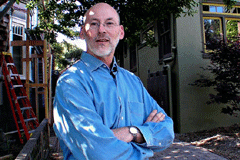
Henry Siegel is certified in environmental architecture. (Photo: Lonny Shavelson)
GOTTFRIED: They put an air blower on a door so they can track the air loss. And then they run around with caulk and weather stripping and foam, and tighten it up. And in that day we tightened it up by 50%. And it was $600. It tightened it up more than brand new windows, which could be $30,000. So if we just ran around the U.S. doing that.
SIEGEL: It would save an enormous amount of energy.
SHAVELSON: Siegel agrees that eco simplicity is the real eco sexy.
SIEGEL: It only costs four, five hundred dollars to get the guys to come in with infrared cameras and do all the testing to tell you exactly where your worst leaks are and to fix them. And that’s the really fast payback.
GOTTFRIED: And also create the green collar jobs, because it’s low tech.
SHAVELSON: Low tech? You’d think the two connoisseurs of green would get together and talk up a solar storm of techno-eco-babble. Surprisingly, their main message is – don’t sweat the big stuff; take care of the basics. I tell them I’m thinking of putting solar on my old, leaky home. Their faces don’t exactly light up with the idea.
GOTTFRIED: So many folks just want to slap solar on their inefficient homes, and that's really, as we know, the last thing -- even though it's the coolest thing, perhaps.
SHAVELSON: And, says Gottfried, the most ecologically crucial part of his house, isn’t in or on the building. It’s where it’s located.
GOTTFRIED: We’re flat, walkable, six homes from a grocery store and half a mile from the BART. But we were in the Berkeley Hills, and I didn’t REALLY want to green that home because it wasn’t walkable. What’s interesting here since we moved is how little I drive.
SHAVELSON: Gottfried says that if you start at the basics and then climb up to green nirvana on a ladder of ecological gadgetry as he did– each step higher costs more and yields less. And, says architect Siegel, all that green stuff loaded on a house can look pretty funky. What he really liked about Gottfried’s eco-elegant but architecturally straightforward home was…
SIEGEL: This looks like a craftsman house, it doesn’t look like it’s trying to be something other than it is. The sign of maturity is that people realize that green is not a style, that it really can fit with any style of architecture and make it more comfortable and more efficient.

The house where the Gottfrieds live rates platinum on the LEED building scale. (Photo: Lonny Shavelson)
GOTTFRIED: I have to go further. Today I met with a fuel cell company that has personal home fuel cells.
SHAVELSON: So while Gottfried continues his ascent to an environmental heaven – the rest of us might do almost as well with our feet still firmly on earth. For Living on Earth, I’m Lonny Shavelson in Berkeley, California.
Better, Greener Real Estate

A drawing of the Twinbrook Station redevelopment project.
CURWOOD: Well, as homeowner David Gottfried observed, location also plays a role in the environmental footprint of housing. So the Leadership in Energy and Environmental Design program from the U.S. Green Building Council now also has a program for whole neighborhoods.
In 2007, some 240 development projects across the country joined a pilot program, and since then 29 of those projects have gotten LEED certification. Sophie Lambert is Director of LEED for Neighborhood Development and she joins me now.
Welcome to Living on Earth!
LAMBERT: Thank you Steve, hi.
CURWOOD: What are the goals of designing neighborhoods with green building principles?
LAMBERT: Well in terms of LEED for Neighborhood Development we’re really looking at three different things at the same time. We’re looking at the location of the project, we’re looking at the form of the project – so is it walkable, is it compact, is it connected to the neighborhoods around it, and then finally, looking at the performance of the buildings and then beyond the actually building parcels looking at the streets and the sidewalks and the storm water runoff, etc.
CURWOOD: So what are the basic principles behind this work?
LAMBERT: So the basic principles are smart growth and so we’re really looking at how a project’s location could potentially reduce vehicle miles traveled, while at the same time directing growth into existing areas. We have the potential to save prime farmland, to save natural habitat.
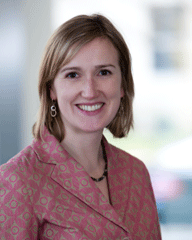
Sophie Lambert is the director of the U.S. Green Building Council LEED for Neighborhood Development program.
CURWOOD: So it would seem that old real estate mantra location, location, location means a lot in your rating system.
LAMBERT: Definitely there is emphasis on location, but we really think that the rating system has the potential to transform the market because it looks at location design and green building performance. So maybe the new mantra is location, design and green building.
CURWOOD: Tell me about some successful projects that have gotten LEED certification for neighborhood development now.
LAMBERT: Well, two that are a certified in different parts of the country that I think have some interesting takeaways – and both actually are public-private partnerships, so a local government played a role as a co-developer in both of these projects. One is called Twinburg Station and it’s actually here in the Washington D.C. area. It’s the redevelopment of a former commuter parking lot for the Washington metro transit system here. And it’s a 26-acre project, it’s gonna have offices, it’s gonna have 1600 units of residential and also quite a lot of retail and 80 percent of the buildings will be green buildings.
The second project I wanted to describe briefly was the Gulch. It’s actually in Nashville, Tennesee, so our first certified project in the southeast part of the country. It was a historic rail yard that was abandoned in the 1990s and it’s adjacent to downtown Nashville. And it’s 60 acres, so they’re really looking at the redevelopment of a large number of historic buildings into residences, offices, retail.
And then also looking forward to the future, I mean, this is a multi-phase project so there’ll be quite a large number of buildings, especially residential buildings that are still going to be built in the coming years, but they will be building them to the standards that they’re following in LEED for Neighborhood Development.
CURWOOD: In what ways may zoning laws conflict with the goals of LEED certification? Can you give me some examples?
LAMBERT: Well many of the types of projects that we’re certifying with LEED for Neighborhood Development might be considered illegal with many zoning codes. So what I mean by that is that some of the zoning codes within the country, actually most zoning codes within the U.S. were created in the 50s or 60s and really focus on the use of buildings, and have very, very high numbers of parking spaces that are required for those projects.
So with more and more development being in urban areas and more and more people thinking about taking transit or walking or biking, people aren’t needing to drive quite as much and so, you know, projects aren’t needing quite as much parking. Maybe they can put the parking behind the building instead of in front of it like much of suburban development is built?
So we’re really looking at hopefully encouraging local governments to re-evaluate their zoning codes and makes them more flexible and to make them more about how the buildings sits up against the street and that relationship between the building and the public realm – that space which is sidewalk, the road, the bike lanes, and that building to building space.
CURWOOD: So, tell me, how do economics and race fit into the redevelopment of neighborhoods and greening them?
LAMBERT: We really think that everybody deserves the right to live in a green neighborhood. And so we actually have quite a few credits that look at social equity issues. We have a credit that encourages affordable rental and for sale housing and not just, you know, isolated in one part of a project. We actually through the rating system are trying to encourage affordable housing to be spread throughout a project and to have a variety of different housing sizes and types available for affordable housing.

A drawing of the Twinbrook Station redevelopment project.
LAMBERT: Well we really see the benefits in terms of trying to influence developers from the very beginning of their process. So if we can try to encourage developers to pick sites that would be eligible for LEED N.D. and really direct growth into existing areas, I think we’d be having a very powerful impact.
And then obviously we’re wanting them to make the choices and the commitment to have green building and green infrastructure from that very early on point. So we’re really hoping that local governments will say, you know, wow, we can really see what the environmental and health benefits will be if this LEED for Neighborhood Development eligible project, if we actually approve it.
CURWOOD: Sophie Lambert, thank you so much.
LAMBERT: Thank you, Steve.
CURWOOD: Sophie Lambert is the director of LEED for Neighborhood Development. She comes to us courtesy of our partnership with the U.S. EPA Smart Growth Program and the National Building Museum. And to learn more about the smart growth speaker series, go to our website loe.org.
[MUSIC: Sonny Rollins Quartet “The House I Live In” from “Scoops” (Le Chant du Monde 2002)]
YOUNG: Just ahead: there’s a new push to cut cold war arsenals – but that does not mean the threat of nuclear weapons is receding. Stay with us on Living on Earth.
Related links:
- LEED for Neighborhood Development
- EPA Smart Growth Program
- Smart Growth Speaker Series
- National Building Museum
- The Gulch, Nashville is the first LEED-certified neighborhood in the South.
Mired in the Mud on the Road to Copenhagen
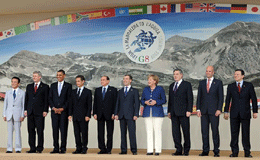
G8 leaders failed to persuade developing countries to halve their emissions by 2050.
CURWOOD: It’s Living on Earth, I’m Steve Curwood.
YOUNG: and I’m Jeff Young.
When the leaders of the G8 and major economies got together in Italy, they struck an agreement to prevent average global temperatures from rising more than two degrees Celsius, that’s about three and a half degrees Fahrenheit. And for the first time the G8 agreed to cut greenhouse gas emissions by 80 percent by 2050.
CURWOOD: But the G8 couldn’t agree among themselves on how to reach these goals, nor how to help developing countries decarbonize their growing economies. President Obama pledged to keep climate negotiations moving forward between now and the key meeting in December in Copenhagen.
Obama: Developed countries like my own have a historic responsibility to take the lead. We have the much larger carbon footprint per capita and I know that in the past the United States has sometimes fallen short of meeting our responsibilities, so let me be clear those days are over.
CURWOOD: Climate diplomacy expert Jennifer Morgan is with the environmental think tank E3G and joins us on the line now from Berlin. Tell me, Ms. Morgan, what do developed countries have to do to close the gap with developing ones such as China?
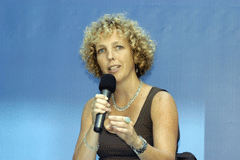
Jennifer Morgan. (Courtesy of Jennifer Morgan)
So they need to see incredible down payments for the short term, for 2020 from developed countries, and they need to see really pragmatic but very fundamental offers on financial support and on technology transfer. Last week Prime Minister Brown from the United Kingdom put a proposal on the table that would, through a range of public and private financing, gather $100 billion to support developing countries to adapt to climate change. Those types of proposals we need to see many more of.
CURWOOD: $100 billion dollars from the world.
MORGAN: Yes, $100 billion dollars from the world.
CURWOOD: So this was the Obama administration’s first appearance on the world summit’s stage on climate change. How did America do?
MORGAN: Well I think so you a fundamental change from the previous eight years from these G8s on climate change. You see the adoption of a goal that the world, including the United States, has now said, you know, if you go above 3.5 degree increase in temperature it’s too much – the impacts are too much. And that I think is a real fundamental shift. And President Obama was there. He adopted that. And from that perspective, I think, you see just a massive difference in the way that the G8 has approached this problem.
CURWOOD: Still, at this point, it looks like the U.S. Congress is willing to do less than what the European Union says it would like to have for example. So how can President Obama walk that line and still get a credible deal in Copenhagen?
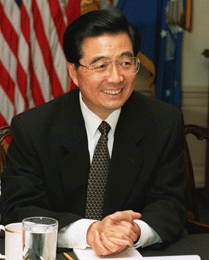
Chinese President Hu Jintao. (Photo: Helen C. Stikkel, Courtesy of the Department of Defense)
CURWOOD: Now this was supposed to be President Obama’s chance to talk with the Chinese President Hu, but of course, Mr. Hu has some civil unrest back home – he had to go home before he really could talk about this at the climate meeting.
MORGAN: Yes, very unfortunate, I think. And I think that took certainly some of the dynamic out of the meeting. But there is a very strong dialogue happening between the U.S. and China right now on climate change and energy and I think they’ve gotta find another time to talk soon.
CURWOOD: Jennifer Morgan, it seems pretty clear what everybody wants in terms of the climate. Nobody wants to go over 3.5 degrees Fahrenheit. The developing countries want the tools to decarbonize. The developing world wants to have a level playing field. What’s the problem with getting to an agreement?
MORGAN: I think fundamentally now it’s a problem of leadership and courage. You have a game of chicken going on, and people not wanting to blink first.

G8 leaders failed to persuade developing countries to halve their emissions by 2050.(Courtesy of the G8)
CURWOOD: Jennifer Morgan is global climate change director of the environmental think tank E3G. Ms. Morgan thanks for your time.
MORGAN: Thank you very much.
[MUSIC: Martial “Cette Fille” from “Putumayo Presents: Euro Groove” (Putumayo World Music 2008)]
Related links:
- Read the G8 statement here.
- Read the Union of Concerned Scientists’ statement on this year’s G8 summit.
- E3G
Protecting the Planet from Nuclear Terrorism
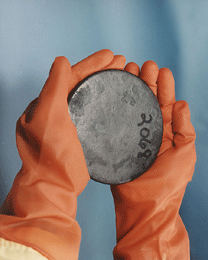
Highly-enriched uranium. A football-sized amount it is sufficient to make a nuclear bomb. (Courtesy of the Department of Energy)
CURWOOD: It’s Living on Earth, I’m Steve Curwood.
YOUNG: And I’m Jeff Young.
President Obama returned from his trip to Moscow with an agreement in principle for the US and Russia to reduce nuclear arsenals by up to a third. It’s one of many steps experts say must be taken to deter proliferation and keep nuclear weapons out of the hands of terrorists.
The Mid East and Asia are rife with nuclear tension. Israel is presumed to have the Bomb, and just last month a senior al Qaeda leader said his group aims to seize Pakistan's nuclear arsenal and use it against Americans. The threat was underscored by the recent suicide bombing of a bus carrying workers from a Pakistani nuclear lab.
CURWOOD: Defense expert Graham Allison says the threat of nuclear terrorism and the resulting human and ecological devastation is greater now than ever. Graham Allison was assistant secretary of defense during the Clinton administration, and is now a professor at Harvard University's John F. Kennedy School of Government.
Professor Allison, welcome to Living on Earth.
ALLISON: Thank you very much for having me.
CURWOOD: And you recently have been serving the federal government with the Weapons of Mass Destruction Commission. Tell me about that work.
ALLISON: Well Congress established a year ago a Commission on Preventing Weapons of Mass Destruction Proliferation and Terrorism - so it’s a mouthful – as a successor to the 9/11 Commission. And we issued our report in December and carefully after a lot of debate and deliberation entitled it “World at Risk.” And the conclusion was that on the current trajectory, terrorists will successfully conduct a nuclear or biological terrorist attack somewhere in the world in the next five years. That’s more likely that not. We’re losing ground. We’re less safe today than we were five years ago. And we’ll be less safe five years from now. So it’s a call for bending the trend lines that are otherwise leading us to a pretty catastrophic consequence.
CURWOOD: Let’s talk about the fundamentals of the threat here. What are the scenarios that you look at in terms of a nuclear terrorist attack?
ALLISON: In the book that I published in 2004 called Nuclear Terrorism: the Ultimate Preventable Catastrophe, in the introduction, I tell the story of Dragonfire.
CURWOOD: Dragonfire?
ALLISON: Dragonfire. Dragonfire is the name of a source, and intelligence source, who reported just one month to the day after 9/11 that al Qaeda had got a small nuclear bomb out of the former Soviet arsenal and brought that bomb to New York City and might be about to explode it.
CURWOOD: Sounds like a movie.
ALLISON: It does sound like a movie. When George Tenet who was then the director of CIA went to give the President’s daily intelligence briefing he explained this to President Bush, and there was a moment to catch breath and then a interrogatory that went something like the following: Did the former Soviet arsenal include weapons of the description of the bomb that Dragonfire had provided? Answer: yes. Were all those weapons adequately accounted for? Answer: No. Could al Qaeda have gotten one of those weapons and brought it to New York City and be about to explode it and we not otherwise know anything about it? Answer: Yes.
So the conclusion from this was there was no basis for dismissing Dragonfire’s report. And on this basis the President ordered nuclear experts to go to New York to look for signs of radiation. And for months after this event, Cheney was missing from Washington because the thought was maybe there would be a bomb in Washington and if it exploded in Washington would destroy the government we have. We would still like to have political authority, so there’s an alternative site that was created during the Cold War where Cheney and actually a couple of thousand people from the agencies of the U.S. government went and stay for some months. Now it turned out to be a false alarm. But the important take away from this is that there was no basis in science, no basis in technology, no basis in logic for dismissing an account that al Qaeda, the guys that just 3,000 people, now had a weapon that would kill 300,000 people.
CURWOOD: So how easy is it, if someone wanted to, to get a hold of nuclear weapons?
ALLISON: Well fortunately you can’t just order up a nuclear weapon from the Internet. Thank goodness. There’s not any for sale on eBay. The happy good news is that is that it’s much more complicated than first blush. Without fissile material, you can’t make a mushroom cloud. Fissile material comes in only two brands: highly enriched uranium and plutonium.
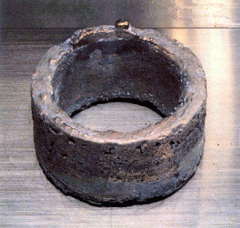
Weapons-grade plutonium. (Courtesy of Department of Energy)
CURWOOD: Or accounted for?
ALLISON: Or even accounted for, because in the former Soviet Union, you had this vast undertaking during the Cold War in which it’s not even clear they knew how much material or how many weapons they ultimately created.
CURWOOD: And as I understand when the Soviet Union collapsed the Stans had a lot of these weapons, Uzbekistan, Turkmenistan…
ALLISON: Ukraine, Kazakhstan. Absolutely. Now I was Assistant Secretary of Defense in 1993, so the beginning of the Clinton administration. And one of the first things I did was with a person from the State Department, we traveled around the places where these nuclear weapons were or had been. Now at the time that the Soviet Union disappeared, so that’s December 1991, there were about 14,000 nuclear weapons, best estimate, left outside of Russia. There were 2620 weapons in Ukraine, about 1000 weapons in Belarus, and we believe all those nuclear weapons were taken out of those fourteen states and back to Russia.
That’s what we believe, in the sense that we haven’t found one anywhere else. But if you said is it possible that some went missing? The answer is: it certainly is. And is it possible that some material from which terrorists could make a bomb went missing? Certainly is. There was a very good report that George Tenet says something about in his memoir of people negotiating to buy four bombs. These were al Qaeda folks in Saudi Arabia. Again, people tried to trace down this story and never got to the bottom of it. There have been rumors that Iran may have bought one or two or several such weapons. So, we haven’t found one of these weapons so far. And I give thanks for that every day. But we don’t know what we don’t know.
CURWOOD: So if someone got ahold of these materials, how easy, how difficult would it be to say bring them into the United States?
ALLISON: That’s a unfortunately an easy question to answer, because one needs to ask how many illegal things of approximately that size come into the U.S. every day? Now, every city knows that drugs come to the U.S. How do they get here? They come in cargo containers, they come in ships, they come across the Mexican border, they come across the Canadian border, they may come in a cell boat. We’re here in Boston, how hard is it to get into a cell boat and sail to Canada? And to sail back? And if you put your cell boat in Marblehead, do you cross some line in the ocean that says you’re entering American water? No, of course you don’t. And when you arrive at the dock in Marblehead, does somebody inspect your boat? No, of course they don’t. So I would say unfortunately the ability of terrorists to bring a weapon to target, we just say follow the drugs.
CURWOOD: And one needs about what – ten pounds of plutonium?
ALLISON: Well ten pounds of plutonium would be sufficient for making a bomb. The easier form of a bomb would be highly enriched uranium. And there ideally you would have about 100 pounds of highly enriched uranium. But its very dense stuff, so this would be smaller than a football.

A billet of highly enriched uranium. (Courtesy of the Department of Energy)
ALLISON: It is. It is. But unfortunately the 9/11 looked like for many people an unbelievable movie that they simply couldn’t imagine. We have to remember that the U.S. who’s the only country to ever use nuclear weapons against another state dropped first a bomb on Hiroshima.
CURWOOD: A small city.
ALLISON: A small city and secondly, a few days later, on Nagasaki.
CURWOOD: Another small city.
ALLISON: Another small city. And at that point, the Emperor of Japan said “uncle, I give up.” So, if one bomb exploded just in one city, a small city, and if there were threats that there were weapons in other cities, well, of course, the question now the president would be wrestling with and his advisors is how likely is it that these guys have another bomb. And since a president couldn’t be seen to be yielding to such blackmail, I suspect you would play it out for the second round. But now, if you’re playing your movie, now two bombs in a second city’s gone off and the threat of a third city. So this is a nightmare.
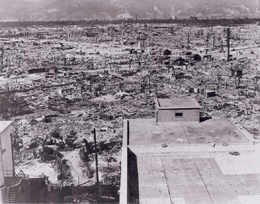
Hiroshima after the United States nuclear attack, which immediately killed about 70,000 people. Tens of thousands more died in the months and years to follow. (Courtesy of the Department of Defense)
ALLISON: Yeah, and I would think you could easily imagine people in cities self-evacuating. Go back to the Dragonfire story that I mentioned to begin with. President Bush decided not to inform the City of New York, including Mayor Giuliani. Remember, this is the month after 9/11. Giuliani’s been the man on the scene, the mayor. So they didn’t inform him about the Dragonfire report that there was a nuclear bomb in the city. And why didn’t they inform him? Because if you inform the mayor, he’s gonna inform the police commissioner. And the police commissioner is going to inform the assistant police commissioner. And pretty soon there’s gonna be a story out that President Bush believes there might be nuclear bomb in New York City, a month after 9/11. You would have had people fleeing the city massively. That thought this would be a panic.
CURWOOD: Now, one thing we haven’t talked about here is a state using a nuclear bomb. Now some folks say that well actually nuclear bombs are pretty useless for states. Why do they say that?
ALLISON: In general, if a state were to use a nuclear weapon, particularly to deliver a weapon via missile against another state – let’s take North Korea – the attack would leave an unambiguous return address. And North Korea would know that the U.S. would know that this missile came from this particular place in North Korea, and the U.S. would respond to this with an overwhelming retaliatory response.
So, the reason why a state would not rationally attack a state that has nuclear weapons like the U.S. with a nuclear weapon is that it would be suicidal. Terrorists who deliver a bomb are not gonna deliver it by a missile. They’re gonna have delivered it by bringing it in the hull of a ship that comes into a harbor, so when the bomb explodes, we’re not gonna be able to identify this unambiguous return address. It’s a huge advantage for a terrorist relative to a state.
Secondly, some terrorists appear to want to be suicidal. So, when you’ve got somebody who is prepared to die in the course of conducting their attack, the threat to kill ‘em doesn’t have quite the same deterrent effect.
CURWOOD: So, if it’s difficult, if almost impossible for a state to use a nuclear weapon, why all the brouhaha about Iran getting nuclear weapons?
ALLISON: Well, that’s a very good question. If Iran succeeds with its current project which will give it a nuclear bomb sometime in the 2012, 13 period perhaps, is that likely to be the end of the story in the region? Or will not Saudi Arabia, which thinks of itself as the leader of the Sunni Muslim community, demand to be equivalent? Will not Egypt which thinks of itself as the political leader of the area?
So most people including myself believe that if Iran becomes a nuclear weapon states, we’ll see a knock-on effect, in effect a cascade of proliferation in the region. The region is already extremely volatile. And in a situation in which other states are pursuing or about to get nuclear weapons, in which Israel probably would attack somebody along the way, one would expect that this would be a very destabilizing scenario. In the same way that if North Korea becomes a recognized nuclear weapon state, most people, including myself, believe that this will end up having a corrosive effect on Japan and maybe South Korea. And as a consequence, if we look at these two virgin cases today, both of them of which are losing hands, I mean, to tell the truth. And the North Korean hand – North Korea has ten bombs worth of plutonium and has conducted a second test. And we can say “you simply can’t do that” but they did it.
So when both of these cases, if they should become nuclear weapon states, I think the whole non-proliferation regime is likely to unravel. And then we would be in a world of multiple nuclear weapon states in which they’re leap-frogging each other – in which I would think it’s likely that nuclear weapons would be used in one or more cases, and that some weapons will become loose and so there’ll be even more opportunities for people like terrorists to destroy our cities.
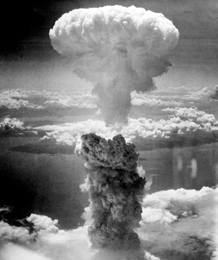
The mushroom cloud from the “Fat Man” bomb rose 18 kilometers into the air over the small city of Nagasaki, Japan. (Courtesy of the Department of Defense)
ALLISON: Well… nuclear or biological.
CURWOOD: Nuclear or biological.
ALLISON: We worked our way through this and we certainly took testimony from all the experts across the U.S. government, from experts in other governments including the British government, the Pakistani government. Unfortunately, the physical facts are such as they are, that there’s people with motive, there’s potential means, and there are huge opportunities. And you put all that together and it seems more remarkable that something terrible hasn’t happened than that something terrible would happen.
CURWOOD: So, as a former assistant secretary of defense, as a person with all the security clearances in this area, you’re sitting here telling me really, it would have been more likely that this would have already happened than not.
ALLISON: In my view. Just because we can now vividly imagine al Qaeda getting a nuclear bomb, bringing it to an American city, destroying the heart of that city, and changing our world. You look at the means available, you look at the opportunity, and I give thanks that it hasn’t happened. But this is a preventable catastrophe.
CURWOOD: How?
ALLISON: There’s a feasible, affordable agenda of actions that if we took, we’d reduce the likelihood of this to nearly zero. And they’re a long complex list, but the core of it is that on the supply side there’s this happy syllogism from physics: no fissile material, no mushroom cloud, no nuclear terrorism. So fortunately they can’t make the fissile material.
What we have to do is make sure that all nuclear weapons everywhere and all nuclear material is locked up as good as gold. How much gold has the U.S. lost from Fort Knox? Zero. So do human beings know how to lock up things that we really care about? Yes, of course we do. Well is there some reason why nuclear weapons and materials should be less secure than gold? I mean, what is gold?
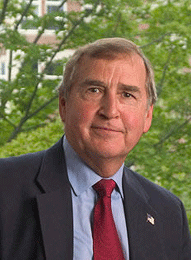
Graham Allison. (Courtesy of Harvard University)
If there are things we can do that reduce the likelihood of that to nearly zero, what in the world are we doing?”
CURWOOD: What are we waiting for?
ALLISON: What are we waiting for? Exactly.
CURWOOD: Graham Allison is author of Nuclear Terrorism: The Ultimate Preventable Catastrophe. He’s a political scientist at Harvard University’s John F. Kennedy School of Government. Professor Allison, thanks so much for your time.
ALLISON: Thank you very much for having me.
Related links:
- For more on Graham Allison, click here.
- Click here for more on nuclear terrorism and Graham Allison’s book.
[MUSIC: Kenny Barron and Regina Carter “Phantoms” from “Freefall” (Verve Music Group 2001)]
YOUNG: Living on Earth is produced by the World Media Foundation. Our crew includes Bobby Bascomb, Eileen Bolinsky, Bruce Gellerman, Ingrid Lobet, Helen Palmer, Jessica Ilyse Smith, Ike Sriskandarajah, and Mitra Taj, with help from Sarah Calkins, Marilyn Govoni, and Sammy Souza.
CURWOOD: Our interns are Annie Glausser and Lisa Song. This show was engineered by Dana Chisholm. Jeff Turton is our technical director. Alison Lirish Dean composed our themes.
You can find us anytime at loe.org. I’m Steve Curwood.
YOUNG: And I’m Jeff Young. Thanks for listening.
Living on Earth wants to hear from you!
Living on Earth
62 Calef Highway, Suite 212
Lee, NH 03861
Telephone: 617-287-4121
E-mail: comments@loe.org
Newsletter [Click here]
Donate to Living on Earth!
Living on Earth is an independent media program and relies entirely on contributions from listeners and institutions supporting public service. Please donate now to preserve an independent environmental voice.
NewsletterLiving on Earth offers a weekly delivery of the show's rundown to your mailbox. Sign up for our newsletter today!
 Sailors For The Sea: Be the change you want to sea.
Sailors For The Sea: Be the change you want to sea.
 The Grantham Foundation for the Protection of the Environment: Committed to protecting and improving the health of the global environment.
The Grantham Foundation for the Protection of the Environment: Committed to protecting and improving the health of the global environment.
 Contribute to Living on Earth and receive, as our gift to you, an archival print of one of Mark Seth Lender's extraordinary wildlife photographs. Follow the link to see Mark's current collection of photographs.
Contribute to Living on Earth and receive, as our gift to you, an archival print of one of Mark Seth Lender's extraordinary wildlife photographs. Follow the link to see Mark's current collection of photographs.
 Buy a signed copy of Mark Seth Lender's book Smeagull the Seagull & support Living on Earth
Buy a signed copy of Mark Seth Lender's book Smeagull the Seagull & support Living on Earth

